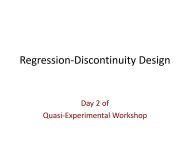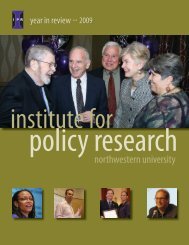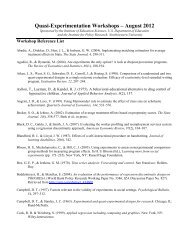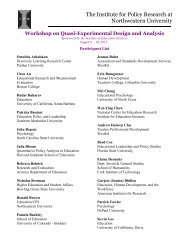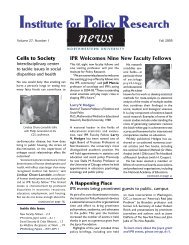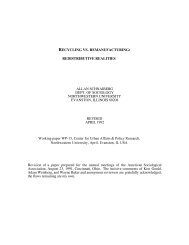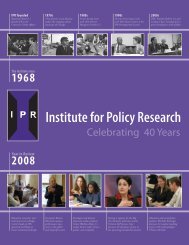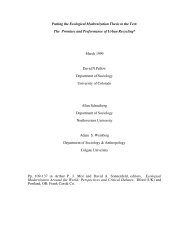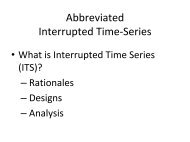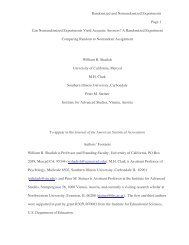pdf - Institute for Policy Research - Northwestern University
pdf - Institute for Policy Research - Northwestern University
pdf - Institute for Policy Research - Northwestern University
You also want an ePaper? Increase the reach of your titles
YUMPU automatically turns print PDFs into web optimized ePapers that Google loves.
and comparable school neighborhoods <strong>for</strong><br />
childhood obesity and physical activity<br />
research. International Journal of Health<br />
Geographics 5(14).<br />
Mason, M., P. Meleedy-Rey, K. K.<br />
Christoffel, M. Longjohn, M. P. Garcia, and<br />
C. Ashlaw. 2006. Prevalence of overweight<br />
and risk of overweight among 3- to 5-yearold<br />
Chicago children, 2002-2003. Journal of<br />
School Health 76(3): 104-10.<br />
Shari Diamond<br />
Diamond, S. S., M. R. Rose, B. Murphy, and<br />
S. Smith. 2006. Juror questions during trial:<br />
A window into juror thinking. Vanderbilt<br />
Law Review 59(6): 1927-72.<br />
Diamond, S. S. 2006. Beyond fantasy and<br />
nightmare: A portrait of the jury. Buffalo<br />
Law Review 54(3): 717-63.<br />
Diamond, S. S. 2006. Juror questions at<br />
trial: In principle and in fact. New York State<br />
Bar Journal 78(8): 23.<br />
Diamond, S. S., M. R. Rose, and B. Murphy.<br />
2006. The costs and benefits—but mostly<br />
benefits—of unanimity. Cali<strong>for</strong>nia Courts<br />
Review Fall:10-13.<br />
Diamond, S. S. 2006. When ethics and<br />
empirics are entwined. In Jury Ethics, ed.<br />
J. Kleinig and J. Levine, 119-30. Herndon,<br />
Va.: Paradigm.<br />
Diamond, S. S., M. R. Rose, and B. Murphy.<br />
2006. Revisiting the unanimity requirement:<br />
The behavior of the non-unanimous<br />
civil jury. <strong>Northwestern</strong> <strong>University</strong> Law<br />
Review 100(1): 201-30.<br />
Daniel Diermeier<br />
Diermeier, D., and S. Gailmard. 2006.<br />
Self-interest, inequality, and entitlement<br />
in majoritarian decision making. Quarterly<br />
Journal of Political Science 41(1): 327-50.<br />
Diermeier, D., with S. M. D. Seaver, R.<br />
D. Malmgren, A. A. Moreira, M. Sales-<br />
Pardo, and L. A. N. Amaral. Social<br />
cognition in complex team networks. 2006.<br />
In Proceedings of the 2005 Workshop on<br />
Social Agents, ed. D. Sachar and C. Macal.<br />
Argonne National Laboratory.<br />
Diermeier, D., with W. J. Hopp and S.<br />
Iravani. 2006. Innovating under pressure:<br />
Towards a science of crisis manage-ment. In<br />
NBER’s Innovation <strong>Policy</strong> and the Economy,<br />
vol. 7, ed. A. Jaffe, J. Lerner, and S. Stern,<br />
125-54. Cambridge, Mass.: MIT Press.<br />
Diermeier, D. 2006. Coalition government.<br />
In The Ox<strong>for</strong>d Handbook of Political<br />
Economy, ed. B. Weingast and D. Wittman,<br />
162-79. New York: Ox<strong>for</strong>d <strong>University</strong> Press.<br />
Diermeier, D. 2006. A strategic perspective<br />
on corporate social responsibility. In<br />
Responsible Leadership, ed. N. Pless and T.<br />
Maak, 155-69. New York: Routledge.<br />
Diermeier, D., H. Eraslan, and A. Merlo.<br />
2006. The effects of constitutions on<br />
coalition governments in parliamentary<br />
democracies. In Democratic Constitutional<br />
Design and Public <strong>Policy</strong>, Analysis and<br />
Evidence, ed. R. Congleton and B. Swedenborg,<br />
133-62. Cambridge, Mass.: MIT Press.<br />
Wendy Espeland<br />
Sauder, M., and W. Espeland. 2006.<br />
Strength in numbers? The advantages of<br />
multiple rankings. Indiana Law Journal<br />
81(1): 205-27.<br />
Sean Gailmard<br />
Diermeier, D., and S. Gailmard. 2006.<br />
Self-interest, inequality, and entitlement<br />
in majoritarian decision making. Quarterly<br />
Journal of Political Science 1(4): 327-50.<br />
Gailmard, S., with F. Boehmke and J. Patty.<br />
2006. Whose ear to bend? In<strong>for</strong>mation<br />
“Despite the dominance of<br />
the Iraq war in the headlines,<br />
Americans have not wavered<br />
from their long-held commitment<br />
to international engagement<br />
on a range of important<br />
issues, nor have they abandoned<br />
their sense of restraint<br />
on the use of U.S. power and<br />
influence, favoring cooperative<br />
and multilateral rather than<br />
unilateral <strong>for</strong>eign policies.”<br />
Page, B. I., et al. 2006. Part I: The<br />
U.S. Worldview. In Global Views<br />
2006: The United States and the<br />
Rise of China and India: Results of a<br />
2006 Multination Survey of Public<br />
Opinion, ed. M. M. Bouton, 13-31<br />
(p. 13). Chicago: Chicago Council<br />
on Global Affairs and the Asia<br />
Society.<br />
www.northwestern.edu/ipr 63



